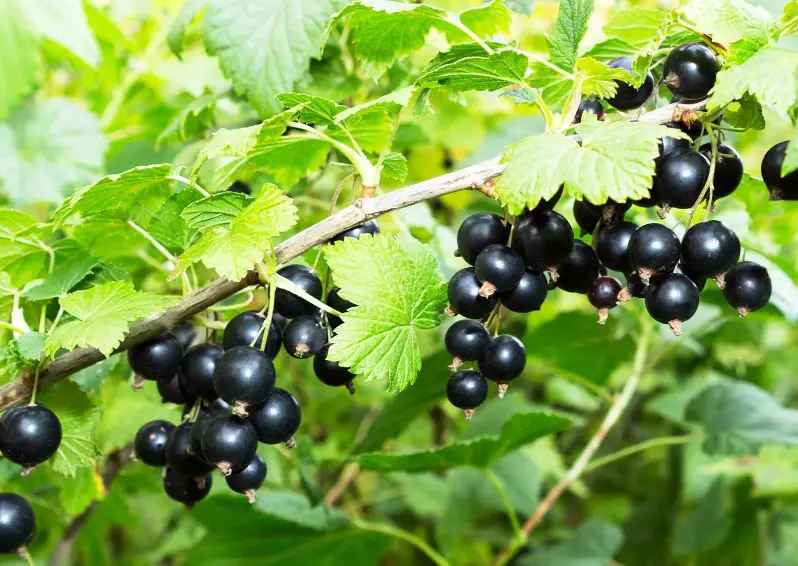In the realm of fruit-bearing shrubs, black currant plants stand out for their distinctive appearance and versatile culinary uses. Originating from Europe and Asia, these robust shrubs have found a renewed appreciation in various parts of the world, including the United States.
Their small, deep purple berries not only offer a tart and flavorful addition to dishes but also contribute to their growing popularity among gardeners and chefs alike.
This guide aims to delve deep into the art of cultivating and caring for black currant plants, offering insights into optimal growing conditions, effective maintenance practices, and the rewarding journey of harvesting these nutrient-rich berries.
About Black Currant Plants

Woody shrubs from Europe and Asia, black currants (Ribes nigrum), were brought to the Americas in the 1800s. They are members of the gooseberry family and are available in several kinds. These berries are gathered throughout the summer to be used in food preparation, beverages, and herbal medicine. They grow on shrubs. Usually growing to a height of 5 feet, the black currant shrub bears clusters of flowers that are pollinated by insects.
The green berries turn into glossy, tasty purple berries by midsummer, and one plant can yield up to 10 pounds of fruit per year. These shrubs are typically planted in the fall or winter, allowing growth to start in the spring, because they are hardy enough to withstand the winter.
They are not well recognized in America because, despite their toughness, they are prone to illness and can transmit fungi. Black currants, however, can be gathered and utilized to make alcoholic beverages, syrups, jams, and other savory and sweet foods.
Black Currant Plant Care and Growing Guide
Planting
Planting black currant plants is best done in the fall or winter, giving the roots ample time to establish before the spring growing season. Select a well-drained location with rich, organic soil to ensure optimal growth. These shrubs thrive in areas that receive full sun to partial shade, providing the necessary light for robust development.
When planting black currant shrubs, it’s important to adhere to proper spacing guidelines to ensure optimal growth and productivity. For single plants, they should be spaced at least 2 feet 11 inches (90 cm) apart in all directions. This spacing allows each plant to have enough room for root development and proper light exposure.
For planting in rows, maintain a distance of 2 feet, 11 inches (90 cm) between each plant along the row, with the rows themselves also spaced 2 feet, 11 inches (90 cm) apart. This arrangement facilitates adequate air circulation and access for maintenance activities like pruning and harvesting.
Soil
Black currant plants thrive in fertile, well-drained soil with a pH between 6.0 and 6.5. To create the ideal growing environment, incorporate organic matter, such as compost, into the soil to enhance its quality. This addition not only improves soil structure but also boosts nutrient content, promoting healthy root development and robust plant growth. Ensuring the soil is rich and well-prepared is crucial for the successful cultivation of black currant plants, leading to bountiful harvests.
Watering
Black currant plants require consistent moisture, particularly during the growing season. Regular watering is essential, ensuring the soil remains evenly moist but not waterlogged. Applying mulch around the base of the plants can help retain soil moisture and suppress weed growth. Mulching not only conserves water but also provides a protective barrier, keeping the roots cool and promoting healthier growth.
Fertilizing
To promote healthy growth in black currant plants, apply a balanced fertilizer in early spring. This initial feeding supports vigorous development as the plants come out of dormancy. A second application of fertilizer after the berries have set can further enhance fruit production, leading to a more abundant harvest. However, be cautious not to over-fertilize, as this can result in excessive foliage growth at the expense of fruit production. Proper fertilization ensures the plants receive the nutrients they need without compromising their ability to produce high-quality berries.
Pruning
Pruning black currant plants annually during the dormant season is essential for maintaining their health and productivity. During this time, remove any dead, diseased, or crossing branches to improve air circulation and light penetration. Additionally, cut back older wood to encourage the growth of new branches, as younger branches tend to produce more fruit. Proper pruning promotes a healthier plant structure, leading to increased fruit yield and quality.
Pest and Disease Management
Black currants are susceptible to various pests and diseases, including aphids, sawflies, and powdery mildew. To manage these threats, regularly inspect your plants for signs of infestation or disease. Implement organic or chemical controls as needed to address any issues. Proper spacing and annual pruning are also essential, as they improve air circulation and reduce the risk of disease.
Harvesting
Black currants ripen in mid-summer, and it is best to harvest the berries when they are fully colored and glossy. Handle the berries gently during harvesting to avoid bruising, which can affect their quality. Each shrub has the potential to yield up to 10 pounds of fruit annually, providing a bountiful harvest when properly cared for.
Uses
Once harvested, black currants offer a versatile range of culinary uses. These berries are prized for their rich, tangy flavor and are commonly used to create delicious jams, jellies, and syrups. They add depth and complexity to baked goods such as pies, muffins, and cakes, enhancing both sweetness and acidity profiles.
Beyond their traditional kitchen uses, black currants are also popular in beverage production. Their juices are refreshing and vibrant, either enjoyed fresh or used as a base for cocktails and mocktails. Black currants are also a key ingredient in the production of wines and liqueurs, where their robust flavor profile shines through, imparting a distinctive fruity character.
What Is the Flavor of Black Currant?
Black currants are characterized by their distinctive flavor profile, noted for their bold and tart qualities attributed to high tannin levels. These berries exhibit strong, earthy tones with a grape-like essence, accompanied by a noticeable acidity reminiscent of cherries.
When dried, black currants develop additional nuances, offering hints of vanilla and wildflower notes. In their dried form, they tend to be sweeter compared to when fresh, enhancing their appeal in culinary uses such as baking and confectionery.
Overall, black currants provide a complex and robust flavor experience that adds depth to a variety of dishes and preparations.
Is it illegal to use black currant in the US?

In the US, black currants are no longer prohibited. Black currants were formerly outlawed in some states because of worries about their effects on native plant species. However, they have since been reintroduced. A portion of the reason for their reappearance is the realization of their great nutritional value—especially their vitamin content, which is beneficial to human health.
In 2006, some states, like New York, repealed their laws, enabling farmers and producers to grow black currants and create new products. States still have different laws, though. For example, Florida allows black currants as long as they don’t have fruit flies, but imports from some nations, such as the European Union, may be subject to limitations. Black currants from nations like Chile must be imported into the US with special licenses.
It is best to manage these rules by speaking with the state’s Department of Agriculture or local government officials for detailed instructions on how to grow, sell, and import black currants. Black currants are becoming more widely available and accepted in the American diet as these regulations change.






